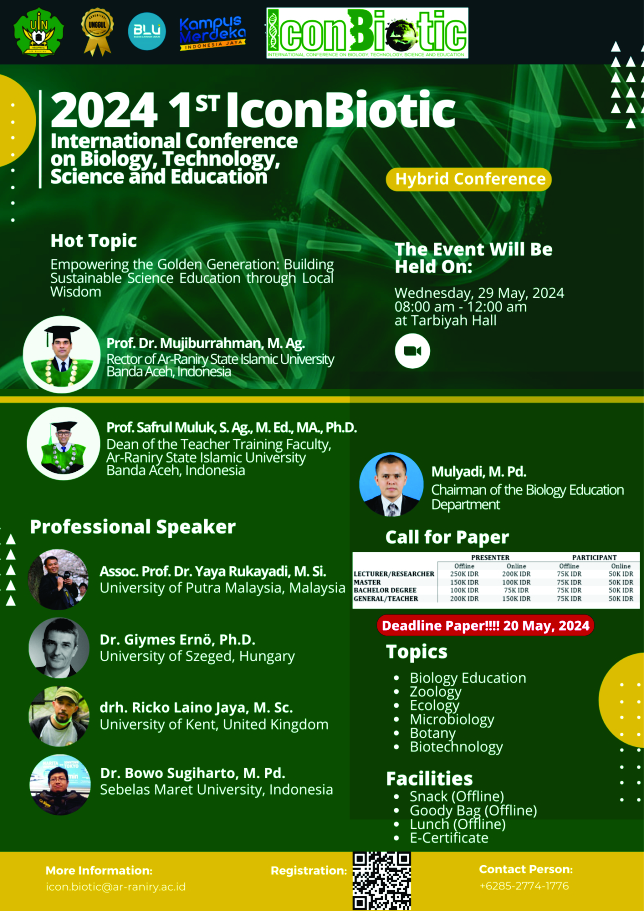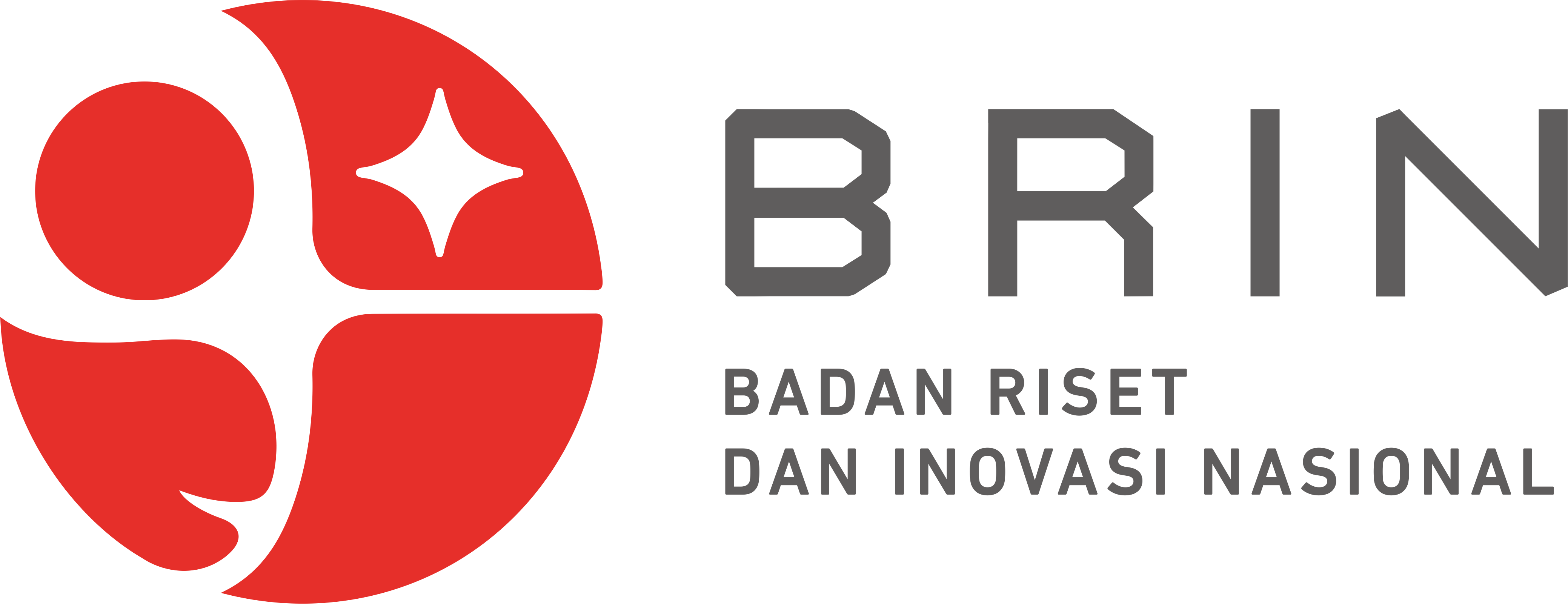EXPLORING THE THERAPEUTIC POTENTIAL OF METHANOL LEAF EXTRACT FROM Ziziphus mauritiana L. : A CANDIDATE FOR TRADITIONAL MEDICINE
Keywords:
Ziziphus mauritiana L., Methanol Extract, Traditional Medicine Candidate, Phytochemical Screening, GC-MS AnalysisAbstract
The tropical herbaceous plant known as bidara (Ziziphus mauritiana L.) offers a number of health advantages. Bidara leaves are traditionally used in Indonesia, particularly in Aceh, to treat a variety of illnesses. Considering its potential health benefits, this research aims to examine the potential of methanol extract of bidara leaves as a candidate for traditional medicine. This research focuses on the results of screening for phytochemical activity in the methanol extract of bidara leaves and the results of GC-MS analysis of secondary metabolites in the methanol extract of bidara leaves as potential candidates for traditional medicine. This research is expected to be able to identify the compounds contained in bidara leaves as a whole and find out the results of identifying secondary metabolites that have the potential to be candidates for traditional medicine. This study used qualitative descriptive methods for phytochemical screening and GC-MS analysis. Bidara leaf extract was obtained by methanol extraction, and its concentration of secondary metabolites, including alkaloids, flavonoids, saponins, tannins, and terpenoids, was then determined by testing the extract with a number of reagents. To determine the chemical structures of the extract's constituents, GC-MS analysis was performed. The findings demonstrated the presence of several secondary metabolites, including alkaloids, steroids, saponins, flavonoids, and phenolics, in the methanol extract of bidara leaves. Several active substances with potential applications in traditional medicine were found through GC-MS analysis. These compounds have various health benefits including anti-inflammatory, antioxidant, and antimicrobial. This research succeeded in identifying active compounds in the methanol extract of bidara leaves which have potential as candidates for traditional medicine. The results of phytochemical screening and GC-MS analysis show that bidara leaves can be further developed as an effective and safe raw material for traditional medicine.
References
Abraham. 2007. Penuntun Praktikum Kimia Organik II. Kendari: Universitas Haluoleo.
Akhyar. 2010. Uji Daya Hambat Analisis KLT Bioautografi Ekstrak Akar dan Buah Bakau (Rhizopora stylosa Griff) terhadap Vibrio harveyi. Makassar: Universitas Hasanuddin. Direktorat Jendral.
Bintoro, A., M.I. Agus., dan S. Boima. 2017. Analisis dan identifikasi senyawa saponin dari daun bidara (Zhizipus Maurtania L. Vol. 7, No. 4, Desember 2019 Zizhipus mauritania L.). Jurnal ITEKIMA. 2(1):84-94.
Ciulei, J. 1984. Methodology for Vegetables and Drugs. Bucharest: Faculty of Pharmacy, Pp. 11-26.
Dahiru, dan OO. 2010. Evaluation of The Antioksidan Effects of Zhizipus Maurtania Lam. Leaf Extracts Againt Chronic Ethanol-Induced Hepatotoxicity In Rat Liver. African Journal Traditional Complementary Alternative Mediines (CAM).
Depkes RI.1995. Materia Medika Indonesia. Jilid VI.Jakarta : Departemen Kesehatan Republik Indonesia.Hal.334,336.
Effendi, Ferry, Anna P. Roswiem, & Ernie Stefani. 2014. Uji aktivitas Antibakteri The Kombucha Probiotik Terhadap Bakteri Escherichia Coli dan Staphylococcus aurens. Journals of Universitas Pakuan.
Gina Lestari,Ike Suciati, dan Herlina. 2020. Formulasi Sediaan Sabun Cair Dari Ekstrak Daun Bidara Arab (Zhizipus Spina – Christi L.) Jurnal Ilmiah JOPHUS: Journal Of Pharmacy UMUS, 1 (02),29-36. Diambil dari http:jurnal.umus.ac.id./index.php/JPK/article/download/5871/4358
Hadizadeh I, Peivastegan B, & Kolahi M. 2009. Antrifungal activity of nettle (Urica diocal L), colocynt (Citrullus colocynthes L. Schrad), oleasnde (Nerium oleander L.) and konar (Ziziphus spina-christi L.) extracs on plant pathogenic fungi. Pakistan journal of biological sciences: PJBS 2009: 12 (1); 58-63.
Harbone, J.B., 1987. Metode Fitokimia: Penuntun Cara Modern Menganalisis Tumbuhan Terbitan Kedua. Penerjemah: Padmawinata K, Soediro I. Bamdung: ITB.
Hendayana, Sumar. 2006. Kimia Pemisahan Metode Kromotografi dan Elektrolisis Modern, Bandung: PT. Remaja Rosdakarya.
Jailani, F., Zaidan, U., Rahim, M., Gani, S., & Halmi, M. (2019). Evaluation of Constituents and Physicochemical Properties of Malaysian Underutilized Ziziphus mauritiana (Bidara) for Nutraceutical Potential. International Journal of Fruit Science, 20, 394 - 402. https://doi.org/10.1080/15538362.2019.1641458.
Kementrian kesehatan RI.2013.Farmakope Herbal Indonesia Edisi I. Jakarta.
Kristanti, A. N, N. S. Aminah. 2008. Buku Ajar Fitokimia. Surabaya: Jurusan Kimia Labotarium FMIPA Universitas Airlangga. Hal:47-48.
Lenny, S. 2008. Uji Bioaktivitas Kandungan Kimia Utama Puding Merah dengan Metode Brine Shrimp, Medan: Universitas Sumatera Utara.
Lumbanraja, I., Wartini, N., & Suhendra, L. (2019). Pengaruh Jenis Pelarut dan Ukuran Partikel Bahan terhadap Karakteristik Ekstrak Daun Bidara (Ziziphus mauritiana L.) sebagai Sumber Saponin. Journal of the Royal Musical Association, 7, 541. https://doi.org/10.24843/jrma.2019.v07.i04.p06.
Prapanza, Ivan dkk. 2012. Khasiat dan Manfaat Sambiloto. Jakarta: Agromedia.
Robinson, T. 1991. Kandungan Organik Tumbuhan Tingkat Tinggi. Bandung: Penerbit ITB. Hal.152-196.
Taher,Thamrin. 2011. Identifikasi Senyawa Flavonoid dari Ekstrak Metanol Kulit Batang Langsat (Lansium Domesticum L). Skripsi.Gorontalo: UNG.


















